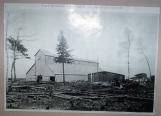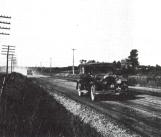22
MORE SALT MINE HISTORYWhen the operation was re-organized in 1948 as the Malagash Salt Company, J. L. Cavanaugh, who had been actively associated with the enterprise from the earliest days acting as mine manager, became president, with George MacKay as a director. The mine was producing from 50,000 to 60,000 tons of salt annually, and had its own 10 mile railway, with the salt hauled out by diesel locomotives. The company also had shipping facitlities on Tatamagouche Bay, near the mine site, with a warehouse having a capacity of over 10,000 tons. Here vessels up to 3,500 tons could be accomodated.
24
SUCCESS AT LASTThe company was reorganized in 1948. Control of the company left New Glasgow in 1951, when the Canadian Salt Company bought, on the open market, all of the common stock. The new owners continued to operate Malagash Salt Company Ltd., as a subsidiary and paid its preferred stock interest regularly.
The deposit at Malagash being nearly exhausted, a new mine was laid out at Pugwash, and shaft sinking began in 1954. The old mine after 41 years and a production of approximately 2 million tons, was abandoned in March, 1959. The new mine at Pugwash went into production in the fall of 1959.
26
THE FIRST MILL WAS DESTROYED BY FIRE JULY 28,1923.Seven men were in the mine as fire started in the mill just after lunch.
William Canfield, Cecil Hartling and George Jewers, recall that foreman Alex Gullens had gone into the mine with seven miners after lunch.
The fire, which started from the diesel engine which ran the hoist or mill (there were two engines) raged for hours and consumed the mill and headframe. Each time the miners climbed up the shaft they were forced to return to the bottom 110 feet below. They soaked jute bags in water found in a sump and built a brattice with wet sacks sewn together with nails, as well as using a wet bag over the face as a filter, or gas mask.
Cecil Hartling estimates they waited about two hours before the fire spent itself out and they were able to climb out. Men on the Surface were throwing buckets of water into the shaft, and the falling water brought welcome fresh air with it.
A close call but all came through it apparently none the worse.
28
EVAPORATED SALTAn evaporation plant was built in 1928. It used brine that was collected in a cavity in the MacKay seam, Brine Pond No. 4 level, and also brine was created on the surface by spraying the waste salt pile.
A high quality coarse salt for the fishery trade was made until 1947 when the process was discontinued.
30
This photo shows a salt clay treated section of highway at Elmsdale, NS on August 16th, 1932. It is believed that highway stabilization was first carried out by the Malagash Salt Company.George W. MacKay said to John MacQuarrie in March, 1972, "We never made any money until we got into the highway salt business."
32
An extract form an interview with Kenny Wilson that mentions why the Malagash Salt Company began shipping salt for use on the highways in Ontario.So where else did they ship to? You said they shipped to Newfoundland with the fish salt; did they ship to Ontario or other parts of Canada?
They started to ship to Ontario because one of our salesmen encouraged the Ontario government to start to use salt on the highway, to take ice off the highway; and it was quite was successful.
Do you remember his name?
Don't remember his name, no. Actually we have his picture downstairs.
So when did they start doing that, do you remember; was that middle fifties?
Yes, that would be about 1953, or something like that.
So did other areas start doing that besides Ontario?
Yes. Once they found out it worked. The one difference about Malagash salt even today, some of the seams of salt we had here in Malagash had a little bit of potash in it; and just a little bit of potash and salt would actually melt ice at ice at a lower temperature. That would be on the old Fahrenheit scale that would melt ice at 5 below zero, and of course the salt they use today doesn't do that?.. But salt and potash with a little bit of water when you mix you see start boiling, the reaction of the two chemicals.






